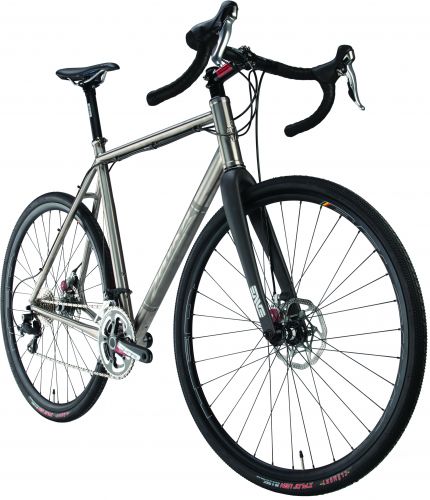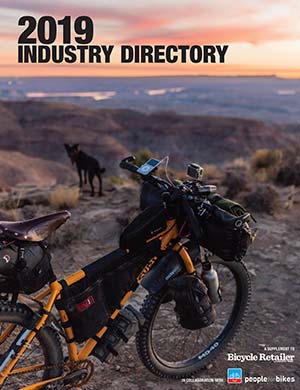BLOOMINGTON, MN (BRAIN) — What is a gravel bike, and why would anyone want one?
The first part of the question will be answered at Interbike as Kona and Salsa introduce bikes targeting gravel riders. The second part of the question is more difficult, as thousands of gravel riders find ’cross bikes more than up to the task of gravel riding.
Salsa’s gravel-targeted Warbird has a design brief beyond gravel riding; it’s intended as a full-out race machine for gravel racers, and it differs substantially from traditional ’cross geometry.
“Gravel races can be anything from 100 miles to the 200-mile Dirty Kanza or 342-mile Trans Iowa,” said Sean Mailen, designer of the Warbird as well as Salsa’s new Colossus all-day road bike.
“A bit more time in the saddle than your average ’cross race, and substantially longer than most road races. So comfort is key, and the reason we offer a model of the Warbird in titanium,” Mailen said.
Mailen, a gravel racer himself, noted calling some routes gravel is a misnomer. Many roads have not seen gravel in more than 20 years. Mix that with a little rain and the mud can be epic.
Given the mud issue, the Warbird gets a top-pull front derailleur, no chainstay bridge and plenty of tire clearance around a 38-millimeter-wide tire.
The larger circumference of big gravel tires lifts the bottom bracket and lengthens trail. Mailen consequently dropped the Warbird’s bottom bracket 2 millimeters and adjusted trail accordingly.
“I also slackened the headtube angle because the descents can be really steep. And because you can descend around a corner at speed and come upon a truck, I added disc brakes,” he said.
Since the Warbird targets the gravel racer more than the gravel rider, it also comes in an aluminum frame for riders wishing to minimize weight and keep the bike stiff for power transfer. While Mailen did as much as he could tailoring tubing profiles to soften the aluminum Warbird’s ride, it is harsher than the titanium version.
Kona’s Mark Matson took a different approach on the brand’s gravel-oriented $1,699 Rove. Noting how many gravel riders are on ’cross bikes, he kept close to Kona’s Jake-inspired ’cross geometry.
Matson increased tire clearance and lengthened the chainstays. Rove fits a 50-millimeter tire, or a 40-millimeter tire with fenders. But the biggest difference from Kona’s ’cross bikes was opting for a steel frame.
“It’s a comfort thing, and steel is a quality ride and peace of mind when you are really out there with no one around. It’s going to finish when a scandium something or carbon fiber frame might not,” he said.
Since Major Jake targets the ’cross racer’s need for a light-lifting rig, it comes with canti brakes. Matson added disc brakes to the Rove to remove braking issues from the rider’s mind. And he notes the Rove’s versatility—Kona is marketing the bike as a commuter as well as a cyclocross bike.
Mark Stevenson, co-founder of the Trans Iowa gravel race with Jeff Kerkove, and owner of gravelgrindernews.com, sees gravel events evolving from their casual, fun-loving beginnings to a more competitive environment today.
“I think there are enough racers now dedicating their efforts solely or mostly to gravel racing that bikes like Salsa Cycles’ Warbird begin to start making sense,” he said. “These bikes will typically offer details not seen on road bikes, like disc brakes, full-run cable housings to ward off grit and grime, generous tire clearances and relaxed geometry for stability. Yet they still will tick the lightweight, high-performance and efficiency boxes that racers generally want in their race rig,” he added.
Lining up next to ’cross bikes at gravel start lines are 29ers, many with front suspension and some fully suspended. And some ’cross bikes also sport Thudbuster suspension seatposts.
Stevenson points out that Trek’s “suspended” road bike, the Domane, not only helped Fabian Cancellara win Strade Bianchi, an Italian gravel race, but Jay Thomas also won the Gravel Worlds in Lincoln, Nebraska, aboard the rig.
Despite the Domane’s gravel success, Trek still targets it toward road racing, but is happy people see the benefit of its Iso Zone technology.
While Salsa’s Mailen says a suspended Warbird is not on the radar, he is watching the Domane and other road suspension bikes closely. And he enjoys the old-school return to elastomeric suspension.
Suspended road designs have not returned to the fever pitch of the ’90s when Bianchi developed a fully suspended Paris-Roubaix bike and RockShox offered its Ruby road fork. But gravel racing has renewed interest.
“I think that before mechanical means for rider comfort and control are explored, though, we must address the suspension and comfort benefits available in the tires,” Stevenson said.
“Tires that can do a better job of this, in the 30- to 45-millimeter category, are only now just emerging. I think riders aren’t quite there with how important tires actually are in this regard, but I feel that will change,” he added.
Donn Kellogg, president of Clément Pneumatics, has gone heavy into tire development for gravel riders. He also thinks there is a lot more to be done in the gravel category, but to really push development one needs a systems approach, developing gravel rims along with tires. Any Clément gravel-specific rim, however, will take time to bring to market.
“A lot of gravel riders today are road riders looking to train off crowded streets, and they gravitate to narrower tires,” Kellogg said.
“Or they are cyclocross riders used to supple tires. Narrow, supple tires get eaten alive on gravel courses, but there are things that can be done to extend tire life,” he added.
The flinty gravel of the popular Dirty Kanzan 200 is strongly influencing gravel tire design. Clément’s premier gravel tires, the X’PLOR USH and X’PLOR MSO, come in a full Kevlar casing—bead to bead—to keep the sharp flint from causing a ride-ending casing slice.
Clément goes 5 millimeters narrower on the 2013 USH, now a 30-millimeter tire, targeting drier, smoother races and riders accustomed to narrower tires.
The beefier MSO gets a new narrower version as well, now available in 32- and 40-millimeter widths. The 120-tpi full-Kevlar versions of these tires sell for $75, and 60-tpi Kevlar-belted versions sell for $60.




